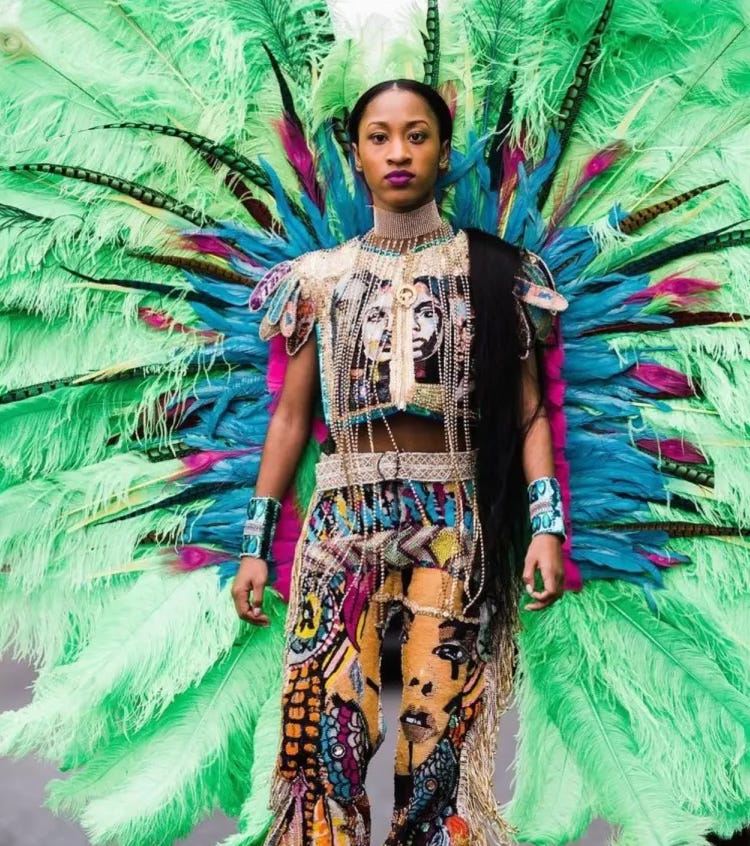Reason for Living #8: Mardi Gras
last year’s rebellion is this year’s restriction
Today’s guest essayist on REASONS FOR LIVING with Esmé Weijun Wang is Eleanor Stern. Mardi Gras this year is on March 4, 2025.
The Christmas lights go down, and New York sinks into sludgy late winter bleakness. I have spent much of my adult life in cold places where the period between New Year’s and the thaw of April feels interminable. Christmas comes and goes too early, before winter really even begins. January starts with a frosty isolated puritanism, bodies marching out of sync in a gray gym to the beat of their AirPods. February finds me in a tailspin of rage. Valentine’s Day is a weak pink antidote to those sickly weeks. Meanwhile, in the far distance, drums are beginning to beat, and parents are wiping green sugar from their children’s mouths. In New York, I ask: Where is our reason for living until spring? Where is Mardi Gras?
My parents used to complain about Mardi Gras. It is a pain in the ass. Weeks out, the streets are unnavigable. Tourists and frat boys vomit on the steps and catcall and throw jagged beer bottles into your yard. On Mardi Gras morning, Fat Tuesday—the apex and hungover anticlimax of the carnival season—my parents would take us to my grandmother’s apartment. She lived on the parade route, so my sisters and I could go outside and muscle our way to the front of the crowd to demand beads and painted coconuts while the adults ate Popeye’s biscuits upstairs. My dad would stay in, stretch out on the couch, and pick up the day’s Times-Picayune. The front page always showed a blonde sorority girl and a gray-haired doctor or lawyer, both in crowns: the King and Queen and Carnival. He’d brandish the paper and excoriate the whole thing. If I call him on Mardi Gras Day this year, he’ll give that same spiel on cue.
The year I was nine, though, my parents did not complain. My mother took my little sister and me to Muses, and all night long, all I remember her saying, over and over again, was only in New Orleans. Muses is an all-women’s parade. Their famous throw is shoes. Exquisitely decorated high heels, thick with glitter paint. To be handed a Muses shoe by a woman in a mask, leaning over the side of the float, is like sipping communion wine from the Pope. That year, my mother kept layering strings of beads on her narrow neck and saying, wonderingly, only in New Orleans. It was six months after Katrina, two months after my family and I returned to New Orleans from Houston. We were living in a friend’s apartment while he camped out at his girlfriend’s place. My mother, who had never lived outside Louisiana until that year, took it up as a refrain: Only in New Orleans. About everything—Potholes. Brass bands. Corruption. Masked women.
That year, there had been much debate about whether Mardi Gras should happen at all. Practically everyone was still displaced in some way, empty lots dotted with FEMA trailers, the wound not just raw but still hemorrhaging. The Mardi Gras debate was only the top layer. Underneath was an entire national conversation about whether New Orleans should exist at all. Hearing it, in snatches, from Houston and then from New Orleans, felt like hearing adults whisper in the next room—understanding just enough to feel a sick curl of unease. The televangelists said that the storm had been a punishment for the city's sins, and the realists said we’d only flood again. Why bother? It would cost so much! That year, Mardi Gras, in its frivolity and wastefulness and impracticality, was a reason to live and a signal that we had decided to go on living.
But I want to return to my father’s Mardi-Gras-Morning crankiness. It didn’t come from nowhere. Mardi Gras revolves around krewes, groups that parade publicly and party privately. The so-called “old-line Krewes,” creations of the nineteenth century, are organizations formed by the city’s white upper-crust. In the 1990s, these Krewes were ordered to certify that they didn’t discriminate based on factors like race and religion. Rather than do so, some of these Krewes disbanded entirely or else stopped publicly parading. But one such Krewe, Rex, became (technically, barely) integrated, admitting a trickle of Black, Jewish, and otherwise once-barred members. It is this Krewe that marches staidly on Mardi Gras Day, and from which the King and Queen of Carnival—white-gowned debutante, old man, gracing the front page of the local paper—are selected. It is both silly, a grownup playground game, and deadly serious, an expression of every injustice that has wracked New Orleans since its founding.
In college, far away from New Orleans, I learned about Bakhtin’s concept of the Carnivalesque and the idea that Carnival celebrations could subvert power hierarchies through play. You crown a false king and a false queen, and, for a day, before lent sets in, you get a taste of a world turned upside down and inside out. The poor can become rich, and the powerless can become powerful. I thought about the crowned Mardi Gras royalty in the society pages and my father’s irritation. What did it mean that the King and Queen of carnival are drawn from the city’s wealthiest from those who least needed a reason to live? My city had abandoned the carnivalesque, letting parody calcify into power—the false aristocracy now just the regular aristocracy in silly outfits.
And yet Mardi Gras keeps churning and shifting. Mardi Gras begins as farce and then hardens into hierarchy, and that hierarchy is perpetually overthrown by a new farce, in a kaleidoscopic rejection of authority. The old-line Krewes have hardened at the top with their blonde coifs and silver scepters. On Mardi Gras morning, before Rex, there is Zulu—the most famous of the all-Black Social Aid and Pleasure Clubs. Once a carnivalesque overthrowing of the segregated holiday, it is now part of the ceremony. Zulu members paint their faces black and throw coconuts. Sometimes, it’s hard to tell whether some element of the holiday is a regressive, nostalgic throwback to horrific racial hierarchy or a winking, subversive parody of it. Every year, new parodies arrive. Bacchus and Endymion, corporate mega-krewes helmed by celebrities. And then Chewbacchus and Barkus, half-formalized krewes to celebrate, respectively, nerd stuff and dogs. Krewe D’etat, raunchy satire wending through the French Quarter. Scrappy little marching krewes where old women and potbellied men shimmy in sequins. Children’s parades.
The city tries to control the carnival. Cops on horseback. Metal barriers to hold crowds back. It doesn’t matter. Mardi Gras eats itself. Mardi Gras spills over. It is an organism, dying and reproducing so fast you can’t catch it. Mardi Gras is toddlers on top of wooden ladders, towering over the crowd to catch beads. It is breathtaking hand-beaded Mardi Gras Indian costumes, tributes to long-ago solidarity between Native Americans and enslaved people. Mardi Gras was finding my little sister in the crowd when we were teenagers and walking home together, arms linked, costumes swishing, picking our drunken way over beads and cracked beer cans. Mardi Gras is months of work with a hot-glue-gun making costumes and shoes and coconuts and practicing dances. It is earnest real effort applied to parody, time and money spent on something that will earn you no cash, no status: foolishness for its own sake, silliness taken seriously. Mardi Gras is waking up one morning in late fall to hear drum beats—the marching band at the school down the street starting to practice.
You can’t cancel Mardi Gras. They did during the pandemic, and fair enough—but still, the air was different on that bitingly cold day. We gathered five feet apart on our porches in costume and drank beer. That year, there were no floats, but people made “house floats,” massive papier-mache confections that turned basic structures for shelter into works of furious frivolity.
Mardi Gras is the triumph of hierarchy, an entrenchment of everything that is wrong with New Orleans. And it is the roaring triumph of the carnivalesque over the hierarchical. It is the frost of February and the violent cracking of the ice. Last year’s rebellion is this year’s restriction. And so you have no choice but to keep going, out of spite if nothing else. You have to live until the thaw. You have to make it to the start of Carnival.
Eleanor Stern is a New York-based writer originally from New Orleans. Her fiction and nonfiction can be found on her Substack, Wicked Tongue, and in outlets like The New Inquiry, The London Magazine, The Southern Humanities Review, and the Tahoma Literary Review. You can find her on TikTok at eleanorstern3.
10% of the proceeds from each REASONS FOR LIVING newsletter go to an organization of the guest essayist’s choice. Breeann has chosen the New Orleans Musicians’ Clinic.
I write because it’s what I do best, and REASONS FOR LIVING with Esmé Weijun Wang is where I share my most personal, thoughtful work—the kind of essays that don’t fit anywhere else. If you enjoy what I write, I’d love for you to become a paid subscriber.
Paid subscribers get two exclusive essays per month in addition to the biweekly Reasons for Living essays, as well as an invite to our monthly Fireside Chats—intimate conversations about creativity, resilience, and the things that keep us going. Your support doesn’t just help sustain this newsletter; it helps sustain me as a writer and artist who is unable to work at a traditional job.
If Reasons for Living has moved you, challenged you, or given you something to hold onto, I hope you’ll consider subscribing. If a paid subscription isn’t possible, a free one is just as appreciated. Either way, I’m grateful you’re here.
Ophelia’s Technicolor G-String: An Urban Mythology
BY SUSAN B. ANTHONY SOMERS-WILLETT
The air tonight is thick as curry;
like every night this summer I could cut it
with my wine glass, spray it with mace.
Over and over it would heal together
like a wound, follow my click and pace of heels
down Conti Street, St. Ann, Bourbon.
Oh Hamlet, if you could see me now
as I pump and swagger across that stage, cape dripping to the floor,
me in three-inch heels and a technicolor G-string—
you would not wish me in a convent.
They’ve made me a queen here, married me off
to a quarter bag and a pint of gin.
The old men tend bark and splatter, rabid
at each table. I think they stay up all night
just to spite the moon. They bring their diseased
mouths to the French Market in the morning,
sell Creole tomatoes to tourists who don’t know
what they are. Each bald head shines plump and red.
It seems like so long ago that I modeled
for those legs outside of Big Daddy’s—
the ones over the door that swing in, out, in, out—
the sculptor made me painted as Mardi Gras.
I thought you might recognize them if you ever passed
with the boys, parading from Abbey to Tavern,
or think them royal feet in need of slippers.
Someday I expect to find you here,
sitting at the table between the first and second rows,
fingering bones or something worse.
And in the end you will throw me a columbine,
light me a Marlboro and take me to a 24-7 where
jukebox light quivers, makes us as thin as ghosts.
But for now, I will dance for the fat man
who sits in your place and sweats his love for me at 3 a.m.,
because only he knows I am Horatio in drag.
What do you find to be pleasurable? How often do you seek it out?
















My daughter in law walks with the muses and Chewbacca
Thanks for writing about your experience so colorfully and vividly! I really enjoyed this piece.